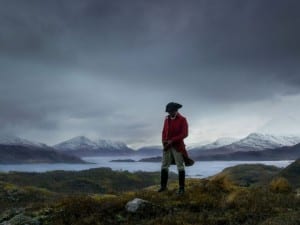In his new exhibition Time and Space at Arnolfini in Bristol, the land artist Richard Long (b. 1945) is back on home turf. Long, who was born in Bristol and continues to live and work in the area, first experimented with walking as a form of making when studying under Anthony Caro at Central St Martins in the 1960s. Reacting against the dominance of Caro’s industrial aesthetic, Long adopted a more conceptual practice in which the act of moving through a landscape became a sculpture in its own right. Geometric traces in the landscape – a circle of stones or a path in the grass – serve as momentary proof of the artist’s presence. These forms are documented by a photograph before being given up to the elements. The exhibition at Arnolfini focuses on the city of Bristol as the start or end point for several of Long’s walks, an axis for the artist’s ideas.
Long’s conceptual work has always translated well to the gallery space and Arnolfini presents a career-wide selection of sculpture, drawings, photography and text works from 1967 to the present day. However, it wouldn’t be a Richard Long exhibition without a walk and it’s worth making the trek up to the off-site sculpture Boyhood Line (2015). Walk along the quay and up through River Avon Gorge, head east through The Downs and you might find your way blocked by 170m of roughly hewn limestone. The length of the sculpture came down to how much limestone Arnolfini could provide, but its width marks out a desire line across The Downs: an informal path etched by centuries of human feet, and the same path walked by Long as a boy. As the solid manifestation of a trace in the landscape, Boyhood Line could be read as the inverse of Long’s formative work A Line Made by Walking (1967). Yet the idea behind the two lines is the same: a minimalist mapping of the self in space, in which the artist is momentarily present and then effaced.
Though not treading the same ground exactly (his walks take place as far afield as Antarctica, Argentina and China), Long’s practice has remained remarkably consistent throughout his career. While some might find his approach formulaic, frozen in a moment of youthful originality, for others the works achieve infinite freedom through theme and variation. His walks are well planned according to rigorous principles: no motorways, no cityscapes, certainly no Google Maps. You won’t find him hitchhiking on the sly (or at least it’s not something he chooses to document) and his studio is free from technicians. His photographs generally keep to a palette of grainy monochrome and his text works document the distance and duration of a walk in no-nonsense Gill Sans. Later text works are increasingly lyrical. Red Walk (2013) offers a bit of local colour: “the blood of a thrush”, “foxgloves” and “a gypsies’ fire”. No abandoned KFC tubs or TK Maxx bags here.
The installation works are less self-consciously ephemeral. The exhibition takes its name from Time and Space (2015), a vast right-angled cross shaped from blocks of slate and stretching across the length and breadth of the gallery floor. The “x marks the spot” metaphor is weighty, but the structure itself is awe-inspiring. An entire side of the first gallery is given over to Muddy Water Falls (2015), where Long has applied River Avon mud directly to the wall in expressive swirls and allowed it to drip down at random. Less effective is the room of fingerprint driftwood drawings, the sort of thing you might find in a seaside boutique.
Though Long would turn his nose up at the term, it’s fair to say his work has acquired the status of a brand; a status which allows him to channel the desire lines of the art market. Chris Drury has talked of the difficulty of entering a market monopolised by Richard Long and Hamish Fulton, and it seems there’s only space for a limited number of successful artists within the vast field of Land Art. Though his art actively seeks to deny any territorial claim, Long guards his artistic identity carefully. When asked whether he would mind if someone adjusted one of his works once left to the landscape, Long looked scornful: “Well they could. But I’d prefer if an animal had done it.”
Meanwhile, defenceless on The Downs, Boyhood Line has become a free-for-all for the budding land artists of Bristol. Stones are being moved from one end to the other, leaving an empty impression on the land. You could call it “taking a line for a walk”.
Matilda Bathurst
Richard Long: Time and Space, until 15 November, Arnolfini, 16 Narrow Quay, Bristol BS1 4QA.
To learn more, visit www.arnolfini.org.uk.
Follow us on Twitter @AestheticaMag for the latest news in contemporary art and culture.
Credits
1. Richard Long, Time And Space, 2015. Courtesy of the artist and Arnolfini Centre.





